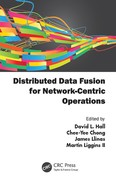I am very pleased to provide the Foreword for this timely work on distributed fusion. I have been involved in fusion research for the last 15 years, focused on transforming data to support more effective decision making. During that time, I have relied heavily on the advice of the editors of this book and many of the chapter authors to help set the directions for Army-focused basic and applied information fusion initiatives.
I first met the editors about 12 years ago at an Army-sponsored fusion workshop where it was clear that the issues of increased sensors and data sources, along with the introduction of web-based information architectures, had finally overwhelmed the analysis community. Most of the discussions were focused on the problems, but Dave Hall and Jim Llinas began addressing the solutions. They identified relevant terms and definitions, outlined algorithms for specific fusion tasks, addressed many of the evolving architectural issues, pinpointed key technical barriers, and proposed directions for future research. They clearly were long-time experts in the field; but, more importantly, they were visionary in their recognition of rapidly evolving trends in information management and the impact those trends would have on the field of data fusion. It is, therefore, not at all surprising that this, their latest book (along with colleagues), would be focused on distributed fusion.
While there are numerous texts and handbooks on data fusion in general (many written or edited by the editors and authors of this book), there are two major trends that motivate the need for this work. First, the very concept of defense operations has dramatically changed. Modern military missions include, for example, coalition-based counterinsurgency, counternarcotics, counterterrorism, and peacekeeping operations. In a sense, the questions have become more complex. The focus is less on detecting the physical aspects of an oncoming tank battalion, and more on detecting networks of operatives or anomalous events, and integrating them with sociocultural concepts. The impact is that historical fusion algorithms, with their reliance on large-system, sensor data–driven, centralized techniques, must now accommodate human observers, open source information, and distributed decision-making conducted at lower and lower echelons.
A second key trend is that rapid changes in information technology have enabled mobile information architectures, changing our concept of where and how fusion algorithms will be employed. As of February 2012, there are 5.9 billion mobile subscribers worldwide, 1.2 billion mobile web users, and 10.9 billion application downloads in place. While implementation of service-oriented architecture (SOA) and cloud concepts continues to be problematic in the mobile ad hoc network environments of the military, this mobile access trend clearly sets the vision for the future in the Department of Defense.
The impact of these trends on fusion requirements includes the need for the following:
• Near-real-time computational speed: The traditional concept of having an individual warfighter disconnected throughout a mission, occasionally contacting analysts for updates, is no longer acceptable. Untethered soldiers will require ready access to data sources. This means that fusion algorithms must run at near-real-time speeds and be tailored to the user’s situation if they are to be effective in supporting tactical operations. In other words, we must begin replacing the notion of large-scale fusion algorithms with small-scale user-adaptive fusion applications.
• Accommodation of more varied data sources: Users will have the ability not only to access data, but to collect and post imagery, voice clips, text messages, etc., as well. Along with this capability comes increased data volume and complexity. Fusion algorithms must handle structured, semistructured, and unstructured data sources alike to support situation awareness. Further, they must rely on data discovery techniques rather than predetermined deductively framed data access; otherwise, they may overlook important new data sources that could prove critical to the decision process.
• Incorporation of trust and confidence concepts: As data sources and users become more widely varied, fusion algorithms must be able to take into account the uncertainties associated with the use of soft data sources, the application of data to problems outside the original scope of the collection effort, and the potential introduction of accidentally or purposefully misleading sources.
So how do we take fusion algorithms, apply them to more complex problems, using more complex data sources, and still meet near-real-time computing constraints? Distributed processing holds out a potential solution, and that solution fits nicely with the concept of cloud computing, where algorithms are automatically distributed across all available resources. However, in reality we know that our current fusion algorithms do not readily lend themselves to parallel techniques. And so it is particularly appropriate that this book begins to tackle the difficult problems of designing and implementing distributed, decentralized information fusion.
Written in a manner that particularly highlights topics of direct relevance to a Department of Defense reader, this text outlines such critical issues as architectural design and the associated impact of network-centric and SOA concepts; fundamentals of estimation, classification, tracking, and threat analysis and their extensions to decentralized implementation; human-centric techniques for visualization and evaluation; and fundamentals of fusion systems engineering.
As is typical for these editors, the chapters provide a well-organized, thorough review of the field from both a theoretical and applied research perspective. The book will most certainly serve as a useful tool for fusion researchers and practitioners alike as we continue to grapple with the critical issue of ensuring our data collection efforts have a clear and positive impact on mission outcome.
Barbara D. Broome, PhD
Chief, Information Sciences Division
U.S. Army Research Laboratory
Adelphi Laboratory Center
Adelphi, Maryland
